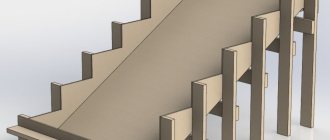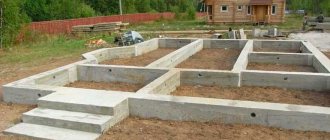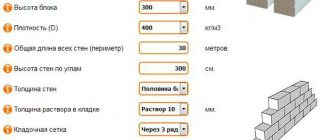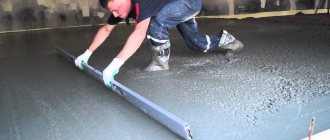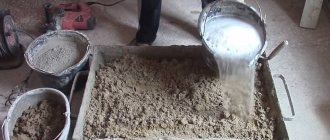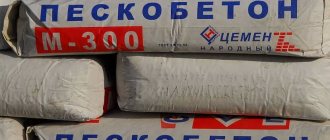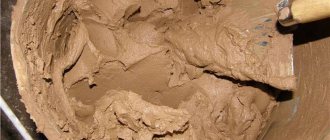The rough or finishing floor covering - concrete screed, is the most popular type of floor for outbuildings, garages, rooms with high humidity, and also the only possible rough floor covering for residential premises in the event of destruction of the wooden floor by fungus.
Considering that the concrete for the screed can be prepared and laid on your own, a concrete screed can be called one of the most “budgetary” options for obtaining a strong and durable floor.
Composition of concrete for screed
The mortar for constructing a concrete floor consists of three components: Portland cement, river (coarse-grained) sand and water. Some sources recommend using plasticizers to improve the workability of the solution, but if the required proportions were observed when preparing the material, the solution fits perfectly on the base without expensive additives.
Building materials stores offer ready-made concrete for screeding in the form of packaged dry mixtures. The advantages of dry mixes are the precise dosage of components and ease of use. However, there is one significant drawback.
The price of ready-made dry mixes is approximately 2 times higher than the dry mix that the developer prepared himself (bought cement, sand and mixed them in the required ratio). Therefore, if the task is to fill a structure at a minimum price, it makes sense to make building material, independently observing the following proportions of concrete for screed installed indoors:
- 1 part cement grade TsEM I 32.5N PC (M400), 3.5 parts clean river sand, 0.6 parts water.
- 1 part cement grade TsEM I 42.5N PC (M500), 4 parts river stove, 0.7 parts water.
When preparing the material yourself, the work of measuring the amount of components and dry mixing is carried out by the developer, so the final product costs much less than packaged material. The above proportions correspond to the brand of solution - M150.
The proportions of concrete for outdoor screed and its composition differ from the proportions and composition of the material for interior work. A screed used in open air conditions experiences significant temperature changes, as well as the harmful effects of precipitation and wind.
A striking example of this type of construction is the blind area around the perimeter of the building. Therefore, to equip such structures, it is necessary to use the M150 grade of concrete for the screed and be sure to iron the surface layer. Proportions of concrete screed used in open air conditions:
- 1 part cement grade TsEM I 32.5N PC (M400), 4 parts clean river sand, 5.5 parts crushed granite, 0.9 parts water.
- 1 part cement grade TsEM I 42.5N PC (M500), 4.1 parts river stove, 5.5 parts granite crushed stone, 0.7 parts water.
For screeds that do not experience a high level of mechanical loads (driving by trucks), it is allowed to replace granite crushed stone with construction waste: broken bricks, furnace slag, broken ceramics, etc.
Why should I use the concrete grade for screed M150? This is where the requirements of the regulatory document SNiP 2.03.13-88 Construction Norms and Rules come into effect. Floors. Clause 5.3 of this document recommends using building material with a compressive strength of at least 15 MPa (150 kgf/cm2) for constructing concrete screeds, which corresponds to the M150 concrete grade.
Columnar
This type of foundation is a kind of pile field, only the support pillars are not driven in with a pile driver, but are poured into prepared pits. A columnar foundation allows you to get a reliable foundation with minimal material consumption. The pillars can have a round or square cross-section; they are placed along the perimeter of the building site and at the junctions of the walls.
The depth of a columnar foundation usually exceeds the freezing depth for a given area, and the above-ground part has a height of 400-500 mm. The building structure can be installed directly on the support pillars, but most often a grillage is installed around the perimeter, which connects the pillars into a single whole.
To calculate the volume of concrete required for pouring a columnar foundation, you need to know the length of the column, its cross-sectional area and the number of columns. If a grillage is provided, its linear dimensions will be required; the volume of the grillage is calculated in the same way as in the case of a strip foundation.
To calculate the volume of pillars with a square or rectangular cross-section, you need to use the following formula:
How to calculate concrete for screed
The algorithm for calculating the amount of concrete that needs to be purchased or prepared independently is simple and consists of several mathematical examples. The initial data for the calculation are:
- Length of the room in meters.
- Width of the room in meters.
- Screed thickness in meters.
- Shrinkage coefficient.
Let's assume that our room has the following dimensions: 4x3 meters, the thickness of the screed is 0.04 meters, and the shrinkage coefficient is 1.022. We multiply the numbers and get the “frequent” amount of concrete in cubic meters: 4x3x0.04x1.022 = 0.49 cubic meters of concrete will need to be produced or purchased to pour a floor screed in a room measuring 4x3 meters.
Many readers of this article may have a question about the numerical value of the shrinkage coefficient of 1.03. It is well known that standard cement mortar and concrete decrease in volume (shrink) when setting and gaining strength. The exception is special expanding concrete.
The amount of shrinkage is characterized by the shrinkage coefficient and depends on a number of factors: aggregate size, amount of foreign impurities, etc. To obtain the true amount of shrinkage, it is necessary to carry out a series of tests and calculations. In order not to overwhelm a simple developer, it is recommended to use the average value between the minimum coefficient of 1.015 and the maximum of 1.03 - 1.015+1.03/2= 1.022
Basics of calculation
To calculate the volume, you need to multiply the width, height and length of the figure into which the concrete will be poured. Mostly you have to work with rectangular shapes. These are reinforced concrete blocks, slabs, foundations and other structures.
Naturally, if the figure is too large, it can be divided into parts to make counting easier. Most often this has to be done when working with a foundation, since the structure is not always rectangular. For example, a house may have various protrusions and other areas that make the shape more complex.
How much cement per cube of concrete for screed
Due to the fact that the proportions of the components of the solution are “tied” to the amount of cement, before purchasing materials for preparing concrete yourself, you must first determine the amount of cement, and then calculate the amount of sand and water. The amount of cement per 1 m3 of screed mortar is regulated by current building codes and regulations:
- 420 kg when preparing a solution M150 based on Portland cement CEM I 32.5N PC (M400).
- 370 kg when preparing a solution M150 based on Portland cement CEM I 42.5N PC (M500).
Accordingly, the amount of sand: 420x3.5=1470 kg or 370x4=1480 kg. Amount of water: 420x0.6=252 liters or 370x0.7=260 liters.
The influence of soil on the depth of foundation.
Ignorance of the characteristics of the soil on which it is planned to erect any building can lead to the fact that it begins to sag and collapse.
As a rule, the top layer of earth has a significant amount of organic residues, which affects its uneven subsidence and shrinkage. Consequently, such a layer of soil cannot be used as a cushion for the base.
Coarse, medium sandy and gravelly soils are best for foundations. The minimum depth for laying can be 0.5 meters. If the soil consists of fine sand or sandy loam, the groundwater level should be taken into account. Since sand, when filled with water, loses its load-bearing properties. Also, when such soil freezes, it can swell and sag unevenly.
As for clayey and sandy loam soils, they have good load-bearing properties, but when wet they begin to sag under their own weight.
In order to determine at what depth it is necessary to lay the foundation, you need to be guided by the following features.
- The number of floors of the building, the type of its construction, the weight of the walls and ceilings.
- The magnitude of the loads on the future foundation.
- The depth of the primary element in neighboring buildings (if they are present).
- Geological and hydrogeological properties of the soil on which construction is planned.
- The base of the soil under the foundation should not be heaving.
- The maximum depth of soil freezing in places where construction is planned.
Having all the information about the features described above, you can determine the most suitable depth for laying the foundation.
Proportions of concrete for screed in buckets
At construction sites of private and country houses, as a rule, there are no scales with large measurement limits. Therefore, it is customary to count and measure the components of mortars and concretes in universal “measuring units” - a bucket. Considering that in order to make a high-quality concrete screed, cement and sand should be measured as accurately as possible, it is worth telling how to do this in “buckets” of popular volumes: 10, 12 and 15 liters.
As an example, consider the proportion of composts for preparing 1 m3 of solution based on Portland cement CEM I 32.5N PC: 420 kg of cement and 1470 kg of sand. To calculate the number of buckets, you should convert the volumes of buckets, and “kilograms” of materials to “volumes” in cubic meters.
First, let's convert the volumes of buckets to m3. Assuming that 1 liter = 1 dm3, and 1 m3 = 1000 dm3, we obtain:
- 10 liters=0.01 m3.
- 12 liters=0.012 m3.
- 15 liters = 0.015 m3.
We reduce the amount of cement to m3:
- It is generally accepted that on average 1 m3 contains 1,300 kg of cement. We determine the percentage ratio of 420 kg per 1 m3: 420x100/1300 = 32.3% (0.323).
- We determine the amount of cement in m3: 1x0.323 = 0.323 m3.
We calculate the “buckets” of cement:
- Bucket 10 liters, pcs.: 0.323/0.01=32.3.
- Bucket 12 liters, pcs.: 0.323/0.012=26.9.
- Bucket 15 liters, pcs.: 0.323/0.015=21.5.
We reduce the amount of sand to m3:
- On average, 1 m3 contains 1,750 kg of river sand. As in the previous case, we determine the percentage ratio in 1 m3: 1470x100/1,750 = 84% (0.84).
- We determine the amount of sand in m3: 1x0.84 = 0.84 m3.
We calculate the “buckets” of sand:
- Bucket 10 liters, pcs.: 0.84/0.01=84.
- Bucket 12 liters, pcs.: 0.84/0.012=70.
- Bucket 15 liters, pcs.: 0.84/0.015=56.
Advantages of working with Asphalt Plant Betonych
Own car park. Delivery 24/7.
Experienced logisticians will deliver everything without hassle on the day of the call to RBU
The LOWEST price for concrete delivery (GOST 7473-2010) in Moscow and Moscow Region
Delivery of asphalt, delivery of sand, delivery of crushed stone, expanded clay concrete and any other non-metallic materials to the site? Don’t have the time or opportunity to look for them in different companies? Order from Betonich, and we will bring you everything at once!
Don't need delivery? In Betonich, ready-mixed concrete is shipped from 5 concrete hubs located in different areas of Moscow. You will receive a free calculation of the volume of building materials and their cost within 1 hour!
Make a powerful breakthrough in the development of your business! The more building materials you order, the more discount you get!
Services of Asphalt Plant Betonych
We strive for long-term cooperation and do everything with high quality.
CemThermo
A specialized highly effective plasticizing and strengthening additive for pouring heated floors.
More details
| Concrete class | Concrete volume | Cement (M400), kg | Sand, kg | Crushed stone, kg | Water, kg | Additive CemThermo, l. | Basalt fiber CEMMIX, g |
| IN 20 | 1 cube | 320 | 672 | 1248 | 150 | 2,6 | 1000 |
| 85 l | 27 | 57 | 107 | 13 | 0,22 | 85 |
